Which of the following regarding BGP Path Identifier is FALSE?
Which of the following is TRUE?
Click the exhibit.
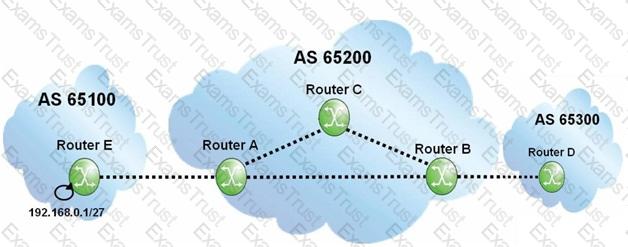
Assuming router A is configured with "next-hop-self", what does the BGP update for prefix 192.168.0.1/27 contain when it arrives at router B?
Click the exhibit.
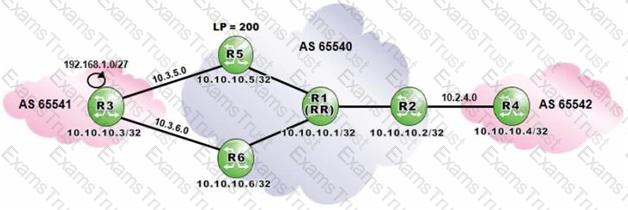
Router R1 is a route reflector with clients R2, R5 and R6. Prefixes advertised by router R5 have a local preference of 200. Router R3 advertises the prefix 192.168.1.0/27 to routers R5 and R6.
Assuming that router R6 is configured with "advertise-external", what is the expected output of "show router bgp routes" when executed on router R5?
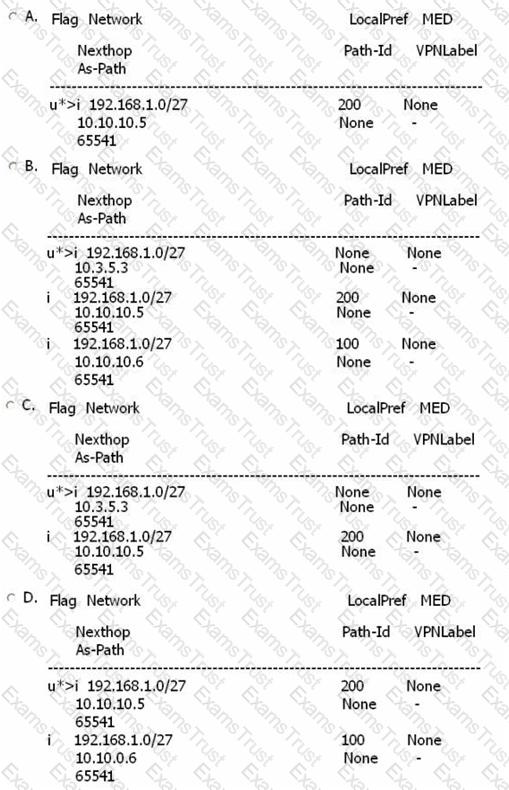
An Alcatel-Lucent 7750 SR receives a route from an eBGP peer without a MED. What MED value is sent to iBGP peers?
Which of the following is TRUE if the state of one BGP neighbor shows Active?
Which of the following is NOT a BGP message type?
Which of the following regarding the TTL of a BGP message is TRUE?
Which of the following is the minimum requirement for an AS to be considered multi-homed?
Which of the following commands would correctly configure the confederation AS number as 65200 with a member AS of 65202?
Consider two Alcatel-Lucent 7750 SRs in AS 65540. Router R1 has system address 10.10.10.1, and router R2 has system address 10.10.10.2. Which of the following configurations on router R2 can establish a BGP session with router R1?
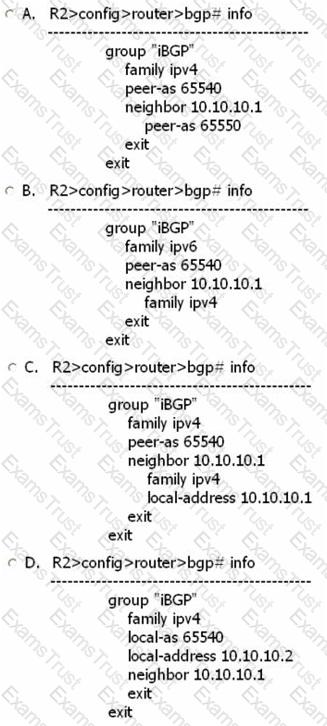
Click the exhibit.
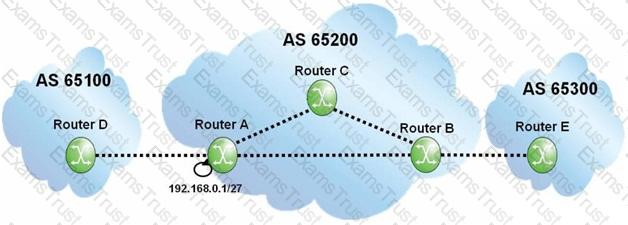
If router A originates a BGP route for prefix 192.168.0.1/27, what will the update contain when it reaches router B?
Click the exhibit.
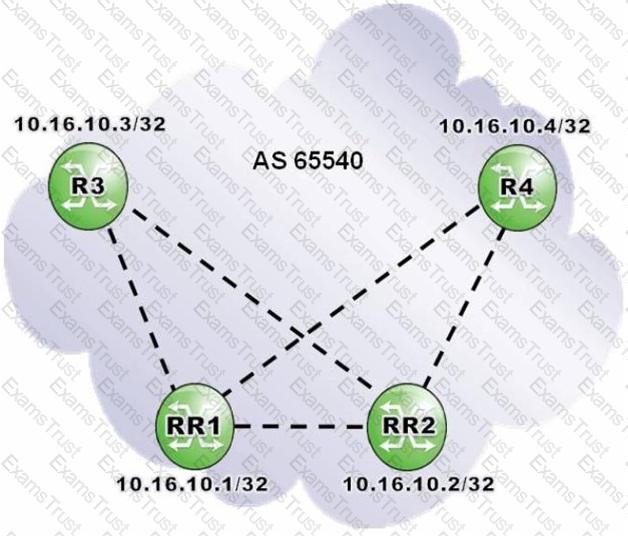
Routers RR1 are RR2 are redundant route reflectors for clients R3 and R4. Which of the following is a valid configuration on router RR1?
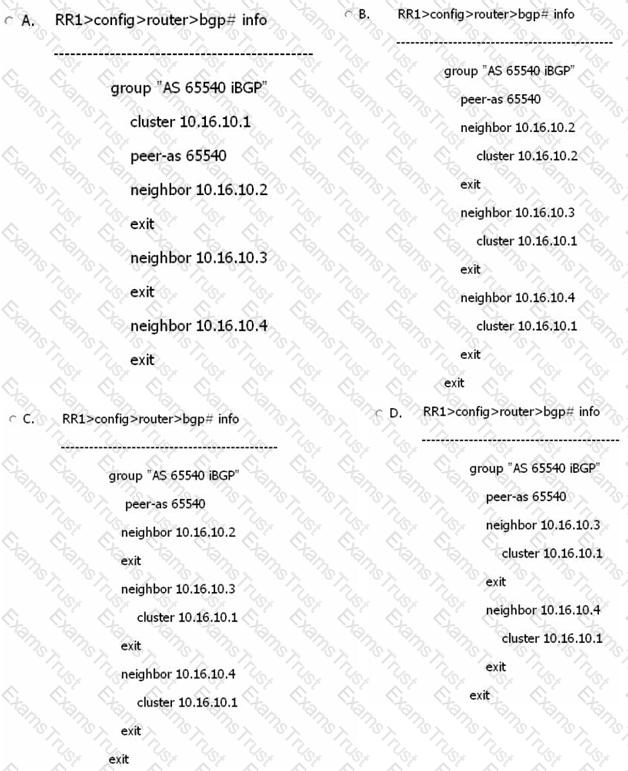
Click the exhibit.
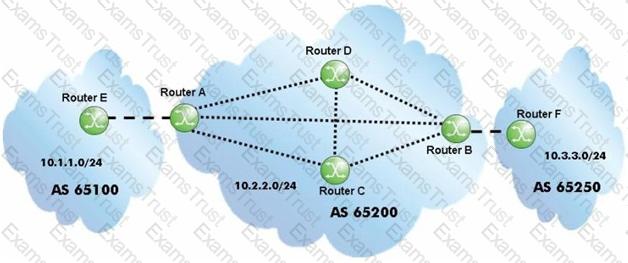
Over which BGP session will router B learn the 10.1.1.0/24 prefix?
When implementing a BGP policy on an Alcatel-Lucent 7750 SR, which of the following types of address space would a typical address plan need to cover?
What kind of BGP attribute is the Local Preference?
Which of the following is considered a best practice for BGP address planning?
Click the exhibit.
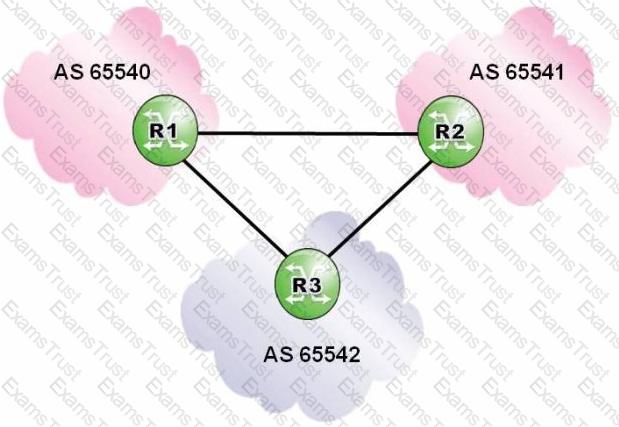
Router R3 is configured with an import policy to reject updates with an AS Path matching the regular expression ".+ 65540". Which of the following regarding updates originating in AS 65540 is TRUE?
Click the exhibit.
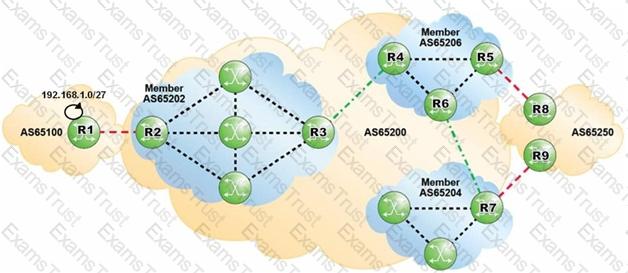
AS 65100 is advertising 192.168.1.0/27 into BGP. Which of the following AS Paths would the prefix 192.168.1.0/27 contain when viewed on router R7?
Click the exhibit.
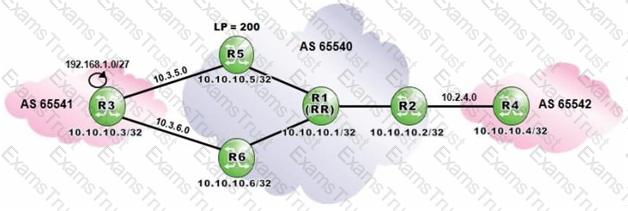
Router R1 is a route reflector with clients R2, R5 and R6. Prefixes advertised by router R5 have a local preference of 200. Router R3 advertises the prefix 192.168.1.0/27 to routers R5 and R6.
Assuming that none of the routers in AS 65540 is configured with "advertise-external", what is the expected output of "show router bgp routes" on router R5?
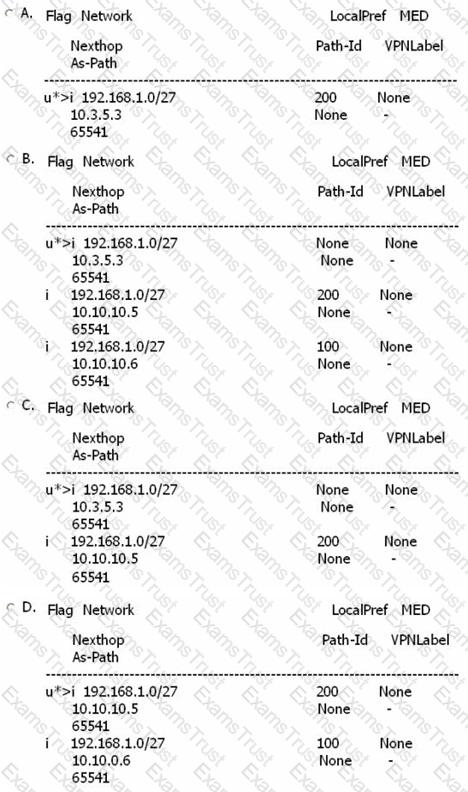
Which of the following statements regarding BGP Fast Reroute is FALSE?
An Alcatel-Lucent 7750 SR is configured with a policy to export directly-connected networks to BGP. Which of the following commands verifies that the export was successful?
Click the exhibit.
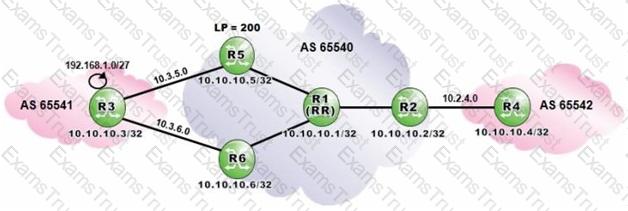
Router R1 is a route reflector with clients R2, R5 and R6. Prefixes advertised by router R5 have a local preference of 200. Router R3 advertises the prefix 192.168.1.0/27 to routers R5 and R6.
Assuming that router R6 is configured with "advertise-external", what is the expected output of "show router bgp routes" when executed on router R1?
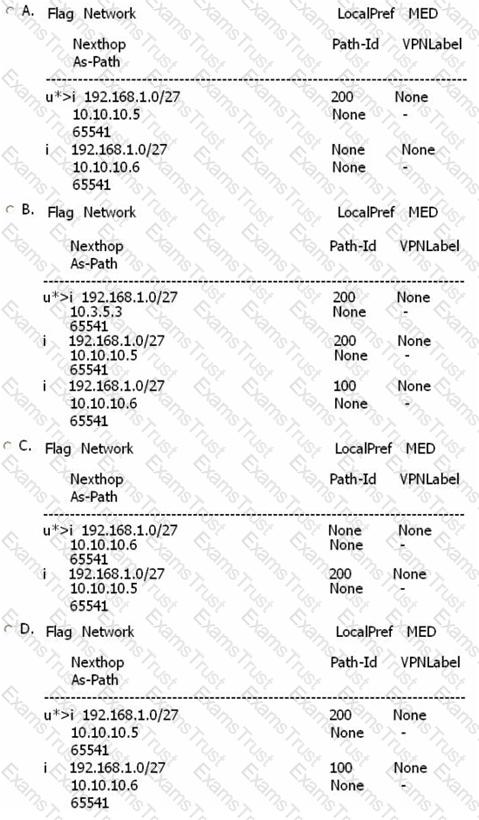
Which of the following regarding BGP confederations is FALSE?
How does the IEEE 802.1ag loopback function differently from the loopback feature in 802.3ah? (Choose 2)
Click on the exhibit below.
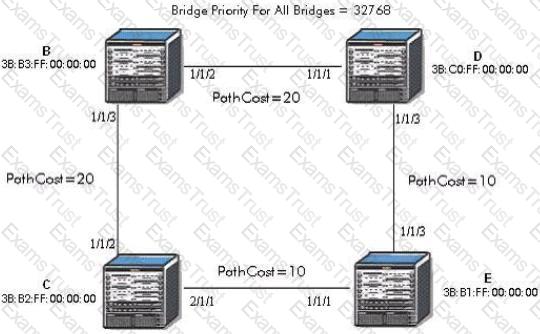
Which port will become the alternate port?
What of the following is a key benefit of Active/Standby pseudowires?
Click on the exhibit below.
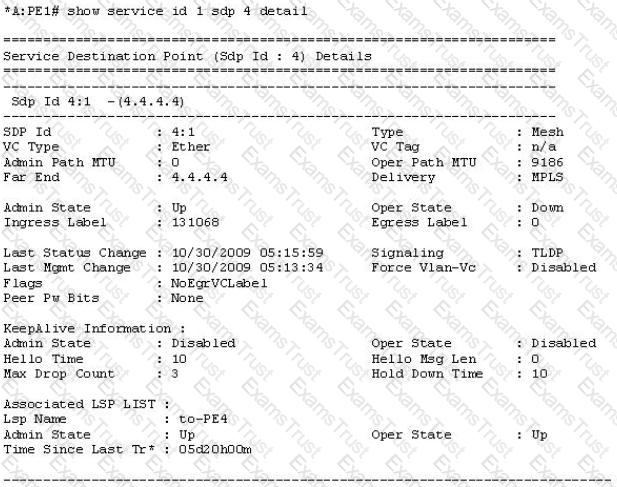
Given the following output what is the most likely reason the SDP binding is operationally down? (Choose 2)
Click on the exhibit below.

The SAP on PE-A has been configured with dot1q encapsulation. The SAP on PE-B has been configured with qinq encapsulation. CE-A sends frames with a single tag of 100. The VLAN tag from CE-A must be passed transparently. CE-B is expecting a frame with a top tag of 200 and bottom tag of 100. Which of the following is the correct SAP id for PE-B?
Which of the following functions must a PE router support when participating in a VPLS service? (Choose 3)
Which of the following best describes the difference between VPWS and VPLS?
An l-VPLS is configured with a service id of 511. What will the value of the l-SID be assuming a default configuration?
Which of the following is NOT a feature of the IEEE 802.3ah EFM standard?
Which OAM tool can be used to dynamically learn the MAC address of a CE device connected to a SAP within a VPLS service?
What function in IEEE 802.1 ah helps to limit the amount of MAC addresses learned in the core?
What action will be taken when an MPLS router receives a frame with a label that does not exist in the LFIB?
Click on the exhibit below.
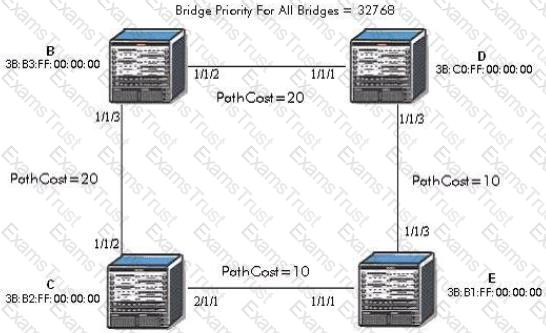
Which ports will become root ports? (Choose 3)
The service mtu of a VPLS is set to 9100. What is the recommended MTU value that can be set for the access port assuming dot1q encapsulation?
In Rapid Spanning Tree Protocol, a Backup Port is on the same switch as a Designated Port?
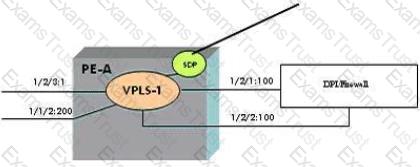
Which of the following features can be enabled to eliminate MAC instability when using policy-based forwarding to redirect traffic to a Layer 2 DPI device?
Click on the exhibit below.

Assume the port on CE-A is sending two tags, a top tag of 100 and a bottom tag of 500. PE-A is configured with a SAP id of 1/1/1:100.*. How should PE-B be configured if CE-B is expecting a top tag of 200 and a bottom tag of 500?
What is the MTU impact on the SDP path-mtu if fast reroute facilities-mode is implemented on the LSP?
Which of the following statements about Spanning Tree Protocol is true?
Which of the following are required for an operational mesh-sdp binding for bidirectional traffic when signaling is enabled within the SDP? (Choose 3)
MC-LAG provides link and node protection from an MDU to 3 or more PE devices.
MAC explosion is best described as a large amount of MAC addresses being withdrawn and relearned?
Why is MAC explosion a factor to be considered when designing a large VPLS network? (Choose 2)
If a management VPLS is administratively disabled what will be the status of the associated user VPLS SAPs?
Click the exhibit.
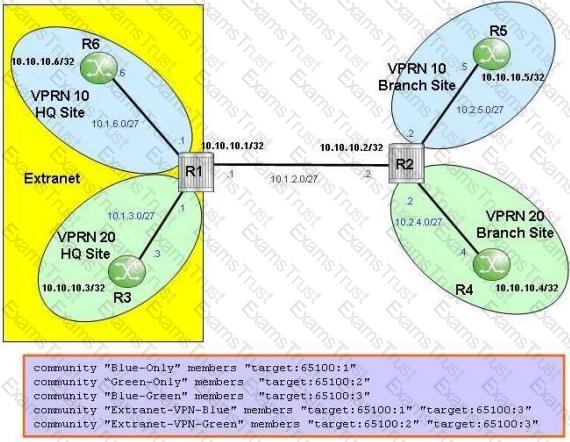
The headquarter sites of VPRN 10 and VPRN 20 are part of an extranet VPRN. Which route targets should be exported under the VPRN 20 service on router R1?
Which method does the Alcatel-Lucent 7750 SR use for the allocation of VPRN labels?
When configuring BGP as the PE-CE protocol on an Alcatel-Lucent 7750 SR, the configuration on the CE is done under the ____________ context and the PE configuration is under the ____________ context.
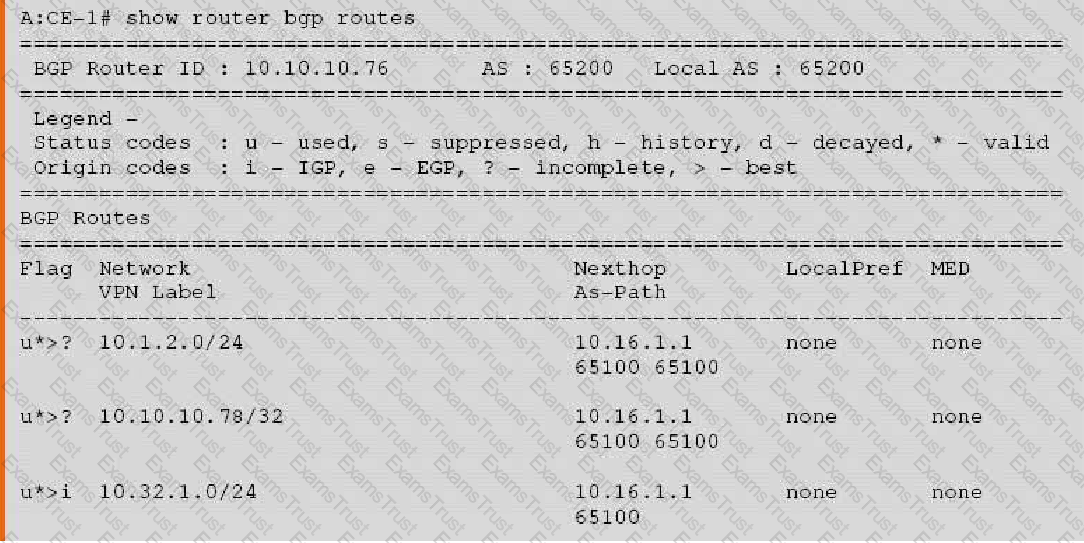
Complete the following statement. In a VPRN, the inner label is used to _______________.
Click the exhibit.
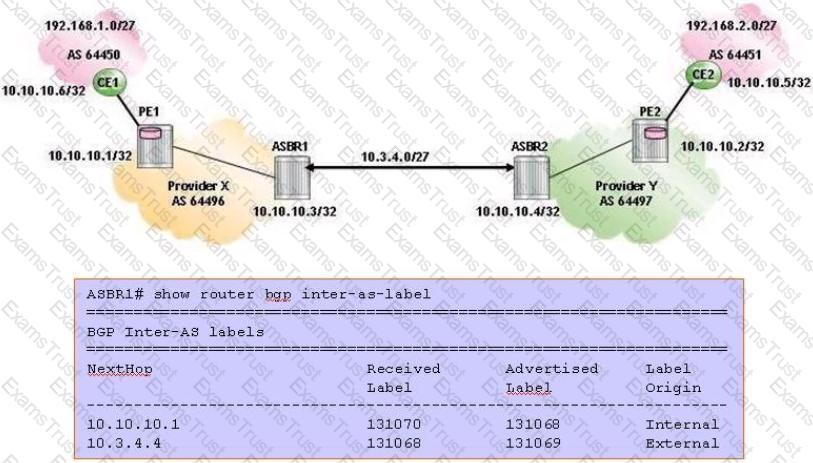
For the Inter-AS model B VPRN, which of the following about the inter-as-label output on ASBR1 is TRUE?
Click the exhibit.
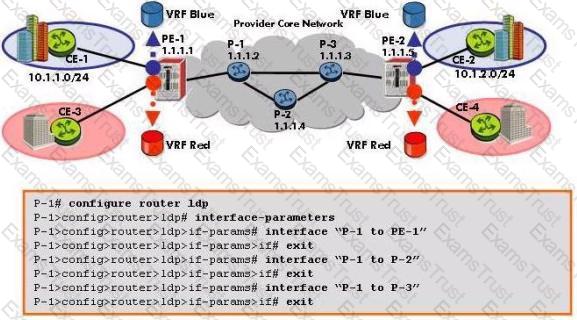
An Alcatel-Lucent 7750 SR is to be configured as a core router that supports VPRNs using LDP as the transport protocol. Which of the following best describes this configuration?
Which of the following is a characteristic of inter-AS model C VPRN?
When a Service Provider offers VPRN services to its customers, which of the following functions are expected to be the responsibility of the Service Provider? (Choose three)
What are the two primary problems the service provider must consider when providing traditional Layer 3 VPN services using only a single common routing table in the provider core? (Choose two)
The policies shown below from the configuration of an Alcatel-Lucent 7750 SR have been created to implement an Extranet VPRN between the main sites of two separate VPRNs. How should these policies be applied?
Click the exhibit.
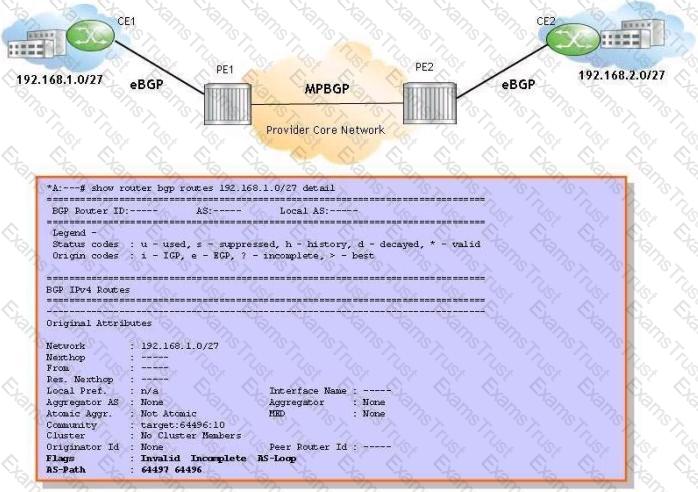
According to the display, a BGP loop is detected for route 192.168.1.0/27. On which router is this command executed?
Click the exhibit.
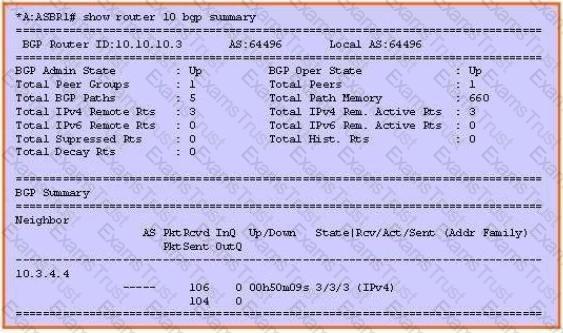
The displayed output is from an ASBR supporting an inter-AS model A VPRN. Which of the following statements about this output is TRUE?
Click the exhibit.
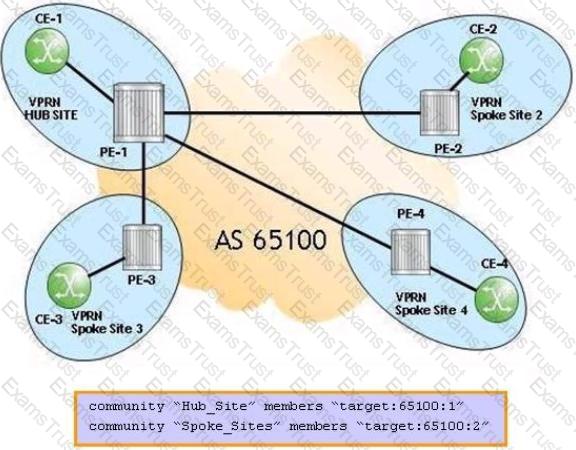
For the PE hub and spoke VPRN, which communities should be imported under the VPRN service on PE2?
Click the exhibit.
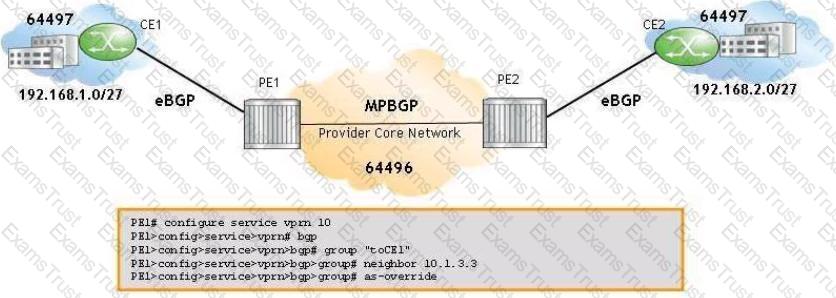
AS-override is configured on PE1 to eliminate the BGP loops. What is the expected AS-Path in the VPN-IPv4 route 64496:10:192.168.2.0/27 received by PE1?
Click the exhibit.
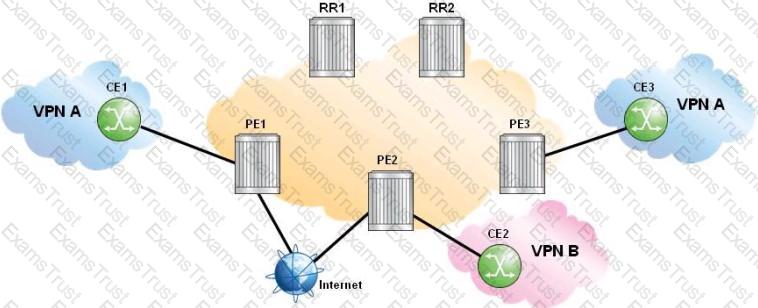
All sites in the displayed network require Internet access. Route reflector 1(RR1) is used for Internet routes only and route reflector 2(RR2) is used for VPN routes only. Which of the following is FALSE?
Click the exhibit.
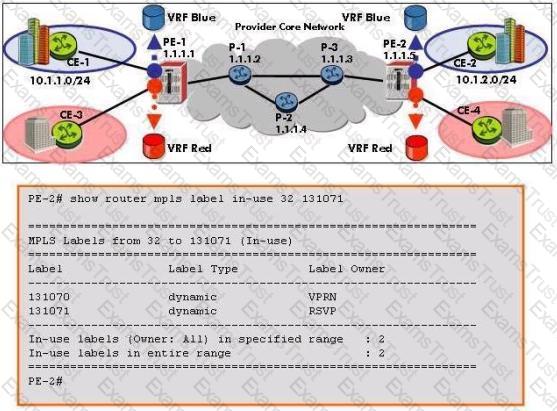
Which of the following best describes the output from the Alcatel-Lucent 7750 SR?
Click the exhibit.
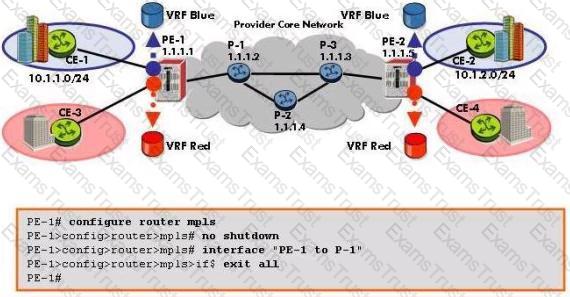
An Alcatel-Lucent 7750 SR is to be configured as a PE router that supports VPRNs using LDP as the transport protocol. Which of the following best describes this configuration?
Which command will display the Route Target associated to a specific prefix on an Alcatel-Lucent 7750 SR?
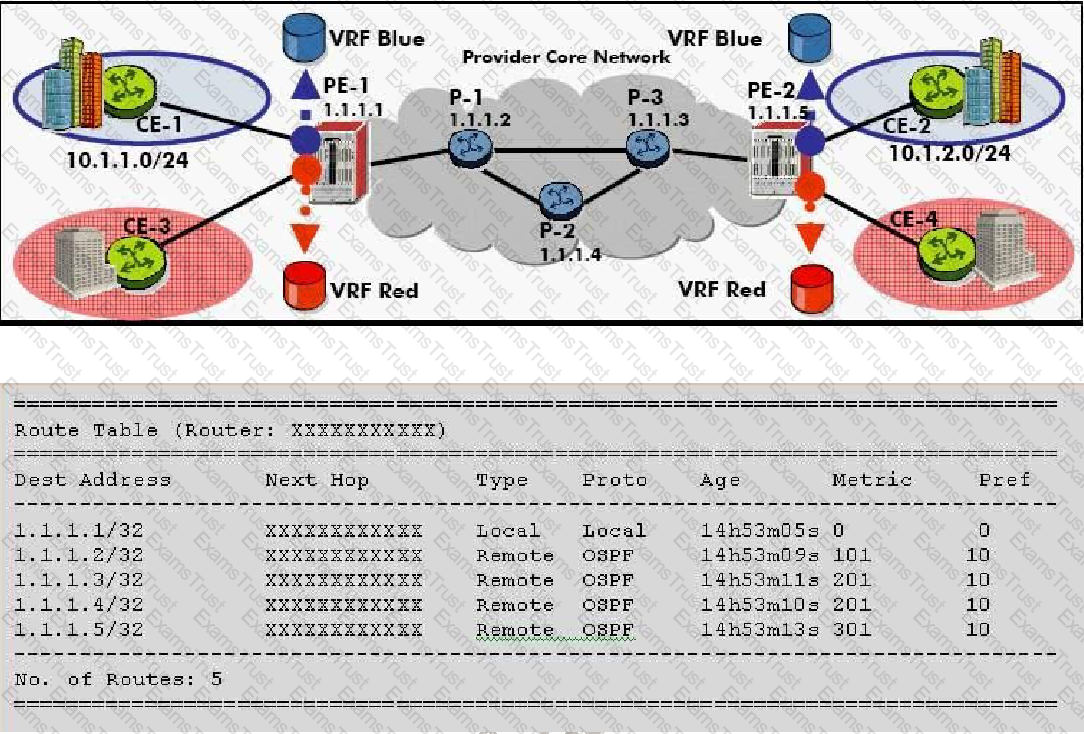
Which command is required in the blank line to complete the configuration shown below on an Alcatel-Lucent 7750 SR?


AVPLS spoke SDP is terminated on a VPRN service. The remote side of the spoke SDP is operationally * Down' with a flag of ' Service MTU Mismatch'. Which command can you use on an Alcatel-Lucent 7750 SR to show the signaled operational VC-MTU?
Which of the following statements is true? Choose the best answer.
A service provider core consists of 6 PE and 4 P routers. Assuming route reflection is not used, how many internal BGP sessions are required in the service provider network for a correct operation of VPRN services?
Click the exhibit.

For the inter-AS model B VPRN, which of the following is FALSE when CE2 sends an IP packet to 192.168.1.1?
Which of the following statements best describes the output from an Alcatel-Lucent 7750 SR shown below?
A service provider is using GRE for his transport tunnel on the Alcatel-Lucent 7750 SR. How can traffic be marked as it traverses the service provider's network? (Choose two)
What is the maximum number of forwarding subclasses a forwarding class can have?
Click the exhibit button below. A network operator has configured the SAP-ingress policy below. Ping traffic is expected in queue 3. However, the network operator notices that all traffic is placed in queue 1. What is the most probable reason for this?
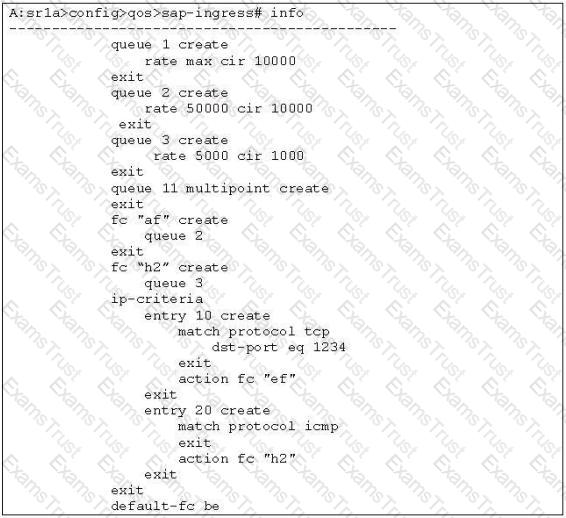
If packets egressing a SAP do not match any criteria defined in the SAP-egress policy, which forwarding class will these packets be assigned to?
Based on queue usage, which of the following QoS-policies when combined will allow queue rates to be dynamically allocated? (Choose two)
Which of the following statements regarding policing and shaping on the Alcatel-Lucent 7750 SR are TRUE? (Choose two)
Which of the following statements are TRUE? (Choose two)
If traffic is destined to queue 5, which has a high-priority-only value of 0 in the network-queue policy, all out-of-profile packets will be dropped.
Which of the following statements BEST describes the IntServ model?
WRED can be used to help avoid TCP slow-start synch problems.
Which of the following statements are TRUE regarding the remarking of packets arriving on the network interface whose ToS-marking-state is set to trusted and remarking enabled on network egress? (Choose two)
Which of the following are categories of forwarding classes on the Alcatel-Lucent 7750 SR? (Choose two)
With hierarchical scheduling, up to ___________ tiers are supported on the Alcatel-Lucent 7750 SR.
Click the exhibit button below. Given that the slope-policy (below) has been enabled and applied on a network port, which of the following statements are TRUE? (Choose three)
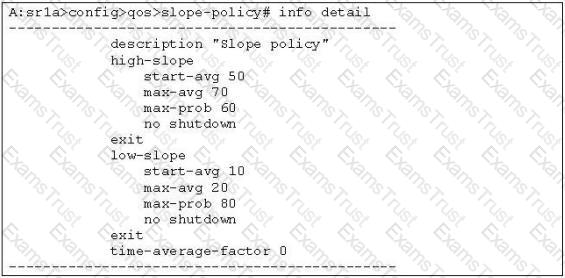
On the Alcatel-Lucent 7750 SR, where can network-queue policies be applied? (Choose two)
A queue is configured with the following attributes:
MBS = 10KB
CBS = 5KB
High-Priority-Only = 30%
Assume that there is no CBS overbooking and that the slope-policy is disabled. If the current queue depth is 8KB, what will happen to an in-profile packet arriving in the queue?
Which of the following statements about a Management VPLS is FALSE?
Which of the following statements is considered best practice when changing a network policy that has been associated with an interface?
When using an egress port scheduler, on which scheduling loop are orphaned queues serviced?
Which of the following should be performed if a service provider does not want packets to make use of the shared buffer space when queued?
Which of the following QoS functions does the slope-policy perform?
Which of the following statements about standalone pokers and CFHP policers is FALSE?
Which of the following is uniquely identified by the VPLS-ID in an LDP VPLS using Auto-Discovery^*